| Columns Retired Columns & Blogs |
People love to bash Stereophile for whatever reason they may have, but this article is an example of truly superior professional writing. Entertaining and engaging while remaining incisive and informative.
I looked at the DarTZeel NHB-18NS's measured performance using its conventional balanced and unbalanced inputs and outputs rather than the 50 ohm, impedance-matched Zeel inputs and DarT outputs. (See Hervé Delétraz's article on the benefits of impedance matching, written for Stereophile before he went into business as a manufacturer, in our November 2001 issue.) This is because I do not have test gear with the necessary 50 ohm impedances. But the preamp's behavior in this mode can be inferred from the performance of its conventional unbalanced operation.
Looking first at the phono stage, as supplied for review this had a gain of 57dB measured at the preamp's unbalanced Tape Out jacks, and an input impedance of 360 ohms across the audioband, both figures appropriate for low-output moving-coil cartridges. The phono preamp was quite quiet, its wideband, unweighted signal/noise ratio (ref. 500µV input at 1kHz and again measured at the Tape Out jacks) measuring a good 60dB. This improved to 69.5dB when A-weighted.
The NHB-18NS had rather more RIAA equalization error than I'm used to seeing in a high-end preamplifier (fig.1), the output at the edges of the audioband being a very audible +1.3 and 2.5dB with respect to that at 1kHz. This will lend the preamplifier a somewhat polite, laid-back balance.
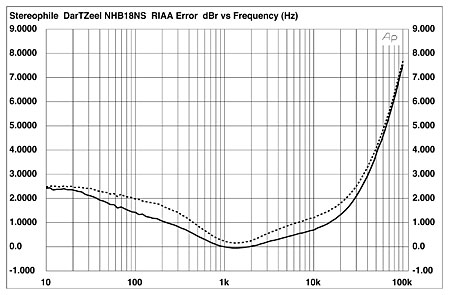
Fig.1 DarTZeel NHB-18NS, phono-stage RIAA error, measured at the Tape Out jacks (1dB/vertical div., right channel dashed).
Note also the rise in RIAA error above 20kHz, which reaches almost +8dB at 100kHz. This is due to the phono preamplifier conforming to the "enhanced" RIAA curve, which uses an additional filter time constant of 3.18µs, which prevents the RIAA rolloff from continuing indefinitely with rising frequency. The rationale behind this is to compensate for the fact that the gain of the record cutting head doesn't rise indefinitely but actually starts to flatten out beyond 50kHz. The enhanced RIAA EQ is thus intended to improve a phono preamp's retrieval of low-level, high-frequency detail. The only other phono preamplifiers featuring this modification of the RIAA curve to have crossed my test bench are the Whest PS.20 (reviewed in the March 2005 issue) and the phono stage of the McIntosh C1000 (reviewed in August 2006). While I understand the intellectual justification for this design trend, I feel it misguided. Both the ultrasonic tip-mass resonance of a typical MC cartridge and the ultrasonic content of record ticks will be emphasized compared with conventional RIAA equalization, with possible audible consequences depending on the downstream components. I wish this were a switchable option.
Phono-stage overload margin was very good, at 21dB or more across the audioband (ref. 500µV input at 1kHz). Harmonic distortion was very low, around 0.01%, with the second harmonic the highest in level (not shown). Even with the modified RIAA curve, the NHB-18NS did well on the high-frequency intermodulation test, the second-order difference component lying at –55dB, or 0.17% (fig.2).
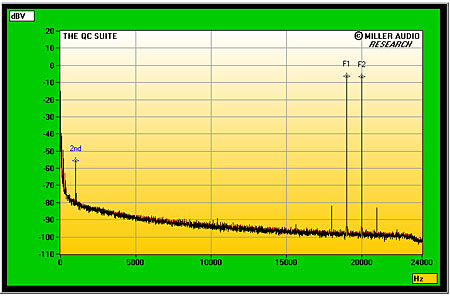
Fig.2 DarTZeel NHB-18NS, phono-stage HF intermodulation spectrum, DC–24kHz, 19+20kHz at 1V peak into 8k ohms, measured at the Tape Out jacks (linear frequency scale).
Turning to the NHB-18NS's line-stage performance, I looked first at the balanced input. Measured at the balanced outputs with the input set to "Pro," this gave a maximum gain of 9.3dB. Switching in the –6dB input pad gave 4.85dB. Absolute polarity was preserved, indicating that the XLRs are wired with pin 2 hot. The input impedance was an extremely low 640 ohms, while the output impedance was a high 2500 ohms at low and midrange frequencies, rising to 3080 ohms at 20kHz. The input impedance is too low for many source components to give their best performance, the output impedance a little high for some power amplifiers.
The balanced input's frequency response didn't vary with different settings of the volume control, but it did peak by 0.75–1.25dB at 42kHz before precipitously rolling off (fig.3, top pair of traces). The audioband response was flat with the input switch set to "Pro," but with the input set to "–6dB," a –0.75dB trough appeared in the treble (fig.3, lower pair of traces). A glance under the preamp's cover told me that the balanced input and output appear to be realized with transformers, which are presumably the cause of the response anomalies. Even so, I don't feel the DarTZeel's balanced inputs and outputs to be of much practical use, the unbalanced jacks being better behaved.
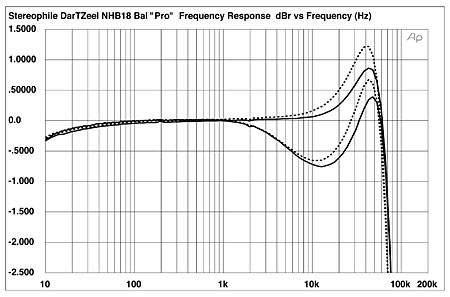
Fig.3 DarTZeel NHB-18NS, balanced frequency response at 1V into 100k ohms with volume control set to maximum and gain set to "Pro" (top) and "–6dB" (bottom). (0.5dB/vertical div., right channel dashed)
Turning to the preamp's performance in conventional unbalanced mode, the frequency response was perfectly flat within the audioband, with a wide bandwidth. The ultrasonic output was down 1.5dB at 200kHz, with no sign of peaking (fig.4). Maximum voltage gain was 10.9dB or 5.34dB, depending on whether or not the –6dB input pad was in circuit. Unbalanced operation preserved absolute polarity, and the input impedance was a moderately high 25k ohms at low and midrange frequencies, dropping to 22k ohms at 20kHz. The output impedance was a usefully low 155 ohms across most of the audioband, rising slightly to 410 ohms at 20kHz.
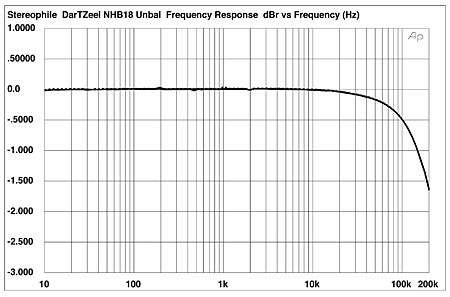
Fig.4 DarTZeel NHB-18NS, unbalanced frequency response at 1V into 100k ohms with volume control set to maximum, and gain set to maximum (top) and "–6dB" (bottom). (0.5dB/vertical div., right channel dashed)
Channel separation (not shown) was excellent at better than 100dB below 2kHz, though it did decrease, at the usual 20dB/decade indicative of capacitive coupling, to a still-good 81dB at 20kHz. This came as a surprise given the preamplifier's dual-mono construction. The wideband, unweighted S/N ratio, ref. 1V output and taken with the input shorted and the volume control set to its maximum, was a moderate 79.2dB. Unusually, switching in an A-weighting filter gave only a slight improvement, to 81.4dB.
Plotting the percentage of THD+noise in the NHB-18NS's unbalanced output against output voltage into loads ranging from 600 to 100k ohms gave the traces shown in fig.5. Below 1V, these traces' upward slope with decreasing frequency indicates that the distortion components are buried in the noise floor at these levels. The true distortion begins to gently rise above 1V, but remains low up to the actual clipping point, which is 5.5V into loads ranging from 10k to 100k ohms and even 4.4V into 600 ohms—well above the level that will be required to drive into overload any practical power amplifier, including DarTZeel's own NHB-108.
Fig.5 indicates that the preamp's linearity is not negatively affected by driving unbalanced loads as low as 600 ohms, which suggests that the darT outputs will be similarly invulnerable. However, while this is confirmed by plotting the THD+N percentage against frequency at 3V (fig.6), a level where the distortion harmonics have risen above the noise floor, this graph also shows a large increase in THD at infrasonic frequencies, rising to >1% below 18Hz. There is also a peculiar rise in the THD+N percentage at 3.5kHz, especially into low impedances. I'm not sure if this behavior will have any subjective consequences, but it did raise my eyebrows a tad.
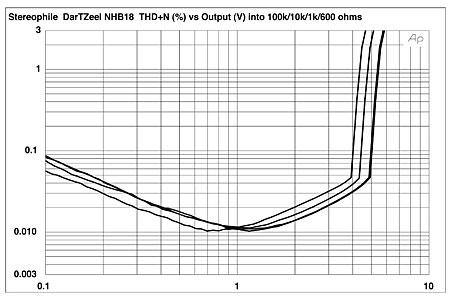
Fig.5 DarTZeel NHB-18NS, distortion (%)vs 1kHz unbalanced output level into (from bottom to top at 2V): 100k, 10k, 1000, 600 ohms.
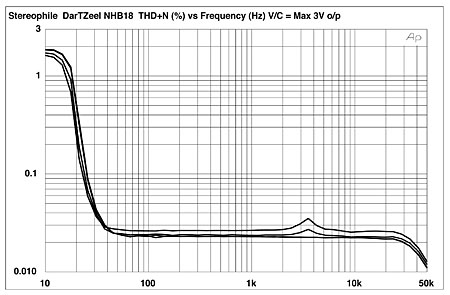
Fig.6 DarTZeel NHB-18NS, THD+N (%)vs frequency at 3V unbalanced into (from bottom to top): 100k, 10k, 1000, 600 ohms.
The distortion is predominantly the benign second harmonic, as revealed by fig.7, an FFT-derived spectrum of the NHB-18NS's unbalanced output while it drove a 1kHz tone at 1V into 8k ohms. The second harmonic lay at –83dB (0.007%) in both channels, with the third harmonic at –105dB (0.0006%). But note the peculiar rise in the noise floor, this time in the region of 7kHz, an octave higher than the small peak seen in fig.6. I have no idea what this behavior is due to or what consequences it might have, but it can also be seen in the plot of the DarTZeel's high-frequency intermodulation distortion performance (fig.8). The actual intermodulation products, however, are well down in level, the difference component lying at just –94dB (0.002%).
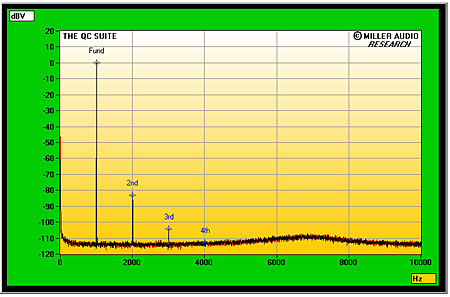
Fig.7 DarTZeel NHB-18NS, spectrum of 1kHz sinewave, DC–10kHz, at 1V unbalanced into 8k ohms (linear frequency scale).
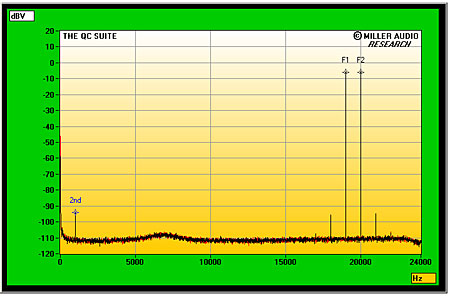
Fig.8 DarTZeel NHB-18NS, HF intermodulation spectrum, DC–24kHz, 19+20kHz at 1V peak into 8k ohms (linear frequency scale).
Though some aspects of its measured performance puzzled me, and I was not impressed with the behavior of its balanced inputs and outputs, overall, the NHB-18NS seemed well engineered.—John Atkinson